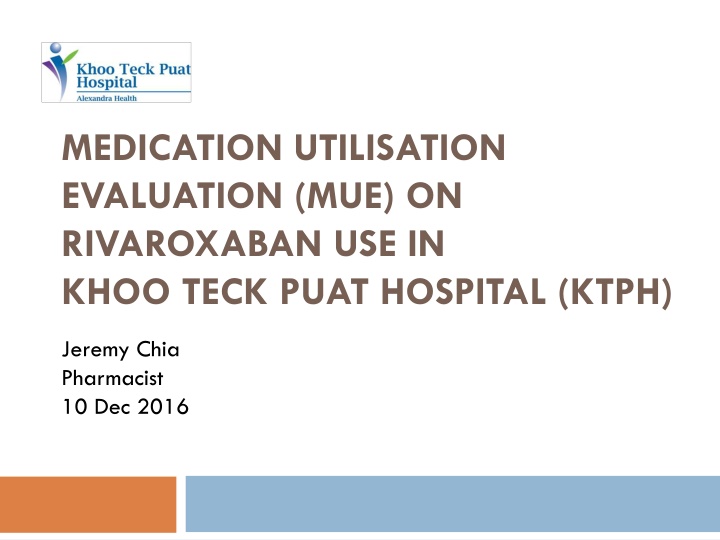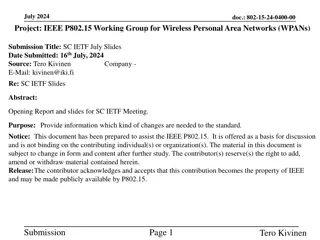
Medication Utilisation Evaluation on Rivaroxaban Use at KTPH by Jeremy Chia Pharmacist
Conducted at Khoo Teck Puat Hospital, this Medication Utilisation Evaluation (MUE) by Pharmacist Jeremy Chia on Rivaroxaban assesses appropriateness of dosage, outcomes for newly started patients, and monitoring frequency. The study highlights the need to evaluate the use of this newer drug to ensure proper usage and monitoring.
Download Presentation

Please find below an Image/Link to download the presentation.
The content on the website is provided AS IS for your information and personal use only. It may not be sold, licensed, or shared on other websites without obtaining consent from the author. If you encounter any issues during the download, it is possible that the publisher has removed the file from their server.
You are allowed to download the files provided on this website for personal or commercial use, subject to the condition that they are used lawfully. All files are the property of their respective owners.
The content on the website is provided AS IS for your information and personal use only. It may not be sold, licensed, or shared on other websites without obtaining consent from the author.
E N D
Presentation Transcript
MEDICATION UTILISATION EVALUATION (MUE) ON RIVAROXABAN USE IN KHOO TECK PUAT HOSPITAL (KTPH) Jeremy Chia Pharmacist 10 Dec 2016 Event Name Date
Scope 2 Introduction to MUE and Rivaroxaban Objectives Methodology Results and Discussion Limitations Conclusion A. B. C. D. E. F.
A. Medication Utilisation Evaluation (MUE) 3 What?1 An evaluation of the use of medications in a healthcare setting Why?1 Determine appropriateness of use of a particular medication in a healthcare setting Review outcomes for safety and effectiveness of a particular medication Ultimately: to improve patient s quality of life 1American Society of Health-System Pharmacists. ASHP guidelines on medication-use evaluation. Am J Health-Syst Pharm. 1996; 53:1953 5.
MUE For Rivaroxaban 4 Relatively new drug compared to warfarin Less need to monitor, less drug-drug or drug-food interactions But No reversal agents (unlike warfarin) Expensive may lead to non-compliance May be used inappropriately not according to guidelines Need to evaluate the use of this newer drug to ensure adequate usage and monitoring
B. Objectives 5 Conduct MUE for Rivaroxaban 15mg and 20mg use in KTPH, to evaluate for: Dose-appropriateness Outcomes (for newly started patients) Monitoring frequency
C. Methodology 6 Retrospective study Patients who collected at least 1 dose of Rivaroxaban 15mg and/or 20mg at KTPH Outpatient Pharmacy within 1st Dec 2015 to 31st Jan 2016 Information obtained from SCM and NEHR (hospital and national database records)
Methodology 7 Table 1: Baseline Demographics Parameters (Total N = 191) Mean Age years (SD) 70.38 (12.68) Mean Weight kg (SD) 66.8 (17.18) [n=176, 15 patients without weight recorded] Male sex n (%) 84 (44.0) Ethnic Groups n (%) Chinese 132 (69.1) Malay 38 (19.9) Indian 6 (3.14) Others 15 (7.85) Prescribed by n (%) Cardiology 121 (63.35) Geriatric 25 (13.09) General Med 21 (10.99) Others* 24 (12.57) *Others include: Diabetes (6), Neurology (7), Resp & Critical Care (3), Dementia Care (2), Pharmacy (1), Gastroenterology (1), Hematology (1), Renal (1), Vascular (1), Rheumatology (1)
Methodology 8 3 aspects are tabulated and discussed: 1. Dose-appropriateness based on manufacturer s standards for approved indications and renal function adjustments2 2. Outcomes for patients newly started on Rivaroxaban from 1st Apr 2015 to 31st Jan 2016 3. Monitoring parameters and frequency appropriateness based on EHRA 2015 guidelines3 2Janssen Pharmaceuticals Inc. (2016, May). Xarelto (R) Package Insert. Titusville, NJ 3Heidbuchel, H et al. (2015). Updated European Heart Rhythm Association Practical Guide on the use of non-vitamin K antagonist anticoagulants in patients with non-valvular atrial fibrillation. EUROPACE , 4-7.
9 D. Results and Discussion
1. Dose appropriateness 10 Based on indications Based on renal functions Table 2: Rivaroxaban dosing based on indications and renal functions2 Indications CrCl (ml/min) Dosage Prevention of Stroke and Systemic Embolism in Non-Valvular Atrial Fibrillation >50 20mg OD 15-50 15mg OD <15 Avoid use Treatment of Deep Vein Thrombosis (DVT)/Pulmonary Embolism (PE) and Prevention of Recurrent DVT/PE 30 15mg BD for 21 days, followed by 20mg OD <30 Avoid use 2Janssen Pharmaceuticals Inc. (2016, May). Xarelto (R) Package Insert. Titusville, NJ
1. Dose appropriateness 11 Dose Appropriateness based on approved indications (N = 191) 140 127 120 ~20% 100 inappropriate dosing 80 60 40 27 22 20 11 4 0 AF DVT/PE Other Indications* Appropriate Not Appropriate *Other Indications: -Ventricular fibrillation (1), Carotid artery thrombosis (1), Post stroke event (1), not reflected in records (8) -Considered as Not Appropriate
1. Dose appropriateness 12 Reasons for dose-inappropriateness (n = 42) 30 25 4 Not renally-adjusted (26%) 20 11 15 Inappropriate dosing for this indication (38%) 10 12 11 5 4 0 AF DVT/PE Other Indications Inappropriate dose for indication Not renally adjusted Others* *Others -AF: no sCr to determine appropriate or not (4) -Other Indications: considered as Not Appropriate (11)
2. Outcomes 15 Outcomes measured for patients newly started from 1st Apr 2015 to 31st Jan 2016 Efficacy reported thrombo-embolic events Safety reported bleeding events
2. Outcomes 16 Whether patients were newly started from 1st Apr 2015 to 31st Jan 2016 (n = 190)* Nil events 79 (41.6%) No; 99 Yes; 91 (47.9%) (52.1%) Thrombo-embolic events 2 (1.1%) Bleeding events 10 (5.3%) *1 patient without initial dose date
2. Outcomes 17 Out of the 91 patients (100%) newly started between 1st Apr 2015 to 31st Jan 2016: 2 patients (2.2%) had reported thrombo-embolic incidents 1 patient had recurrent DVT 1 patient had lower limb pain 2o to DVT: reported may be due to non-compliance because of cost 10 patients (11.0%) had reported bleeding incidents 4 patients had bleeding not directly due to Rivaroxaban use (from trauma [3], from cut [1]) 1 patient had increase bleeding risk ( aPTT and PT) without actual bleed
2. Outcomes 18 Bleeding outcomes in 10 patients (11.0%), compared to that reported in clinical trials ROCKET-AF (14.9%)4, and in EINSTEIN (9.4%)5 8 patients for AF, 2 patient for DVT Could be due to retrospective surveillance in this MUE, as compared to extensive observation during clinical trials Number of patients recalled for this study was also much smaller than in those clinical trials 4Patel MR, Mahaffey KW, Garg J et al (2011). Rivaroxaban versus Warfarin in Nonvalvular Atrial Fibrillation. New England Journal of Medicine (N ENGL J MED), 883-891. 5Prins, M. et al (2013). Oral rivaroxaban versus standard therapy for the treatment of symptomatic venous thromboembolism: a pooled analysis of the EINSTEIN-DVT and PE randomized studies. Thrombosis Journal (THROMB J), 21-30.
3. Monitoring Parameters 19 According to EHRA 2015 guidelines3 Blood Sampling (Renal functions and FBC) If 75yo: monitor every 6 months If CrCl < 60ml/min: monitor at frequency of every (CrCl/10) month Eg. CrCl 40ml/min, should monitor at every (40/10 = ) 4 months Assumption: CrCl rounded to nearest 10s to calculate for frequency DDIs 3Heidbuchel, H et al. (2015). Updated European Heart Rhythm Association Practical Guide on the use of non-vitamin K antagonist anticoagulants in patients with non-valvular atrial fibrillation. EUROPACE , 4-7&12-13.
3. Monitoring Parameters 20 Assumption: Monitoring parameters for non-valvular AF extend to recurrent DVT EHRA 2015 guidelines only meant for non-valvular AF
3. Monitoring Parameters 21 Table 4: Number and Percentage of patients monitored at appropriate intervals N = 176* Renal Functions n (%) FBC n (%) Appropriate intervals 90 (51.1) 79 (44.9) Not appropriate intervals 86 (48.9) 97 (55.1) FBC monitored at appropriate frequency Renal functions monitored at appropriate frequency 97, 55% 90, 51% 86, 49% 79, 45% No* Yes No* Yes *15 patients without CrCl, unable to determine appropriate frequency
3. Monitoring Parameters 22 Appropriateness of renal functions monitoring frequency (N = 176) 60 56 50 40 30 30 19 19 20 13 8 10 7 7 6 6 4 1 0 Yearly 6 monthly 5 monthly 4 monthly 3 monthly 2 monthly Not appropriate Appropriate
3. Monitoring Parameters 24 Appropriateness of FBC monitoring frequency (N = 176) 60 50 45 40 30 28 30 19 20 15 9 8 10 7 7 4 3 1 0 Yearly 6 monthly 5 monthly 4 monthly 3 monthly 2 monthly Not appropriate Appropriate
3. Monitoring Parameters 26 Drug-drug Interactions (N = 191) Amiodarone, 8 None, 172 Other, 19 Clarithromycin, 5 Diltiazem, 3 Phenytoin, 2 Ketoconazole, 1
3. Monitoring Parameters 27 Discussion Only 60 patients (31.4%) were monitored for BOTH renal functions and FBC at appropriate frequency 19 (9.9%) patients with DDIs 3 patients on Amiodarone and 2 patients on Diltiazem with CrCl <50ml/min: to be used with caution Monitoring for renal functions and FBC coupled with appropriate dose adjustments is critical to avoid undesirable outcomes Could be due to lack of awareness for the need to monitor for such parameters at such intervals
Compliance 28 20 random patients who are currently on Rivaroxaban were called and asked about compliance for the past 7 days 19 patients had claimed compliance 7 patients had a family member to help administer 1 patient was not compliant to prescribed instructions Experienced headache, self reduced dose to alternate days without doctor s instructions Upon listening to friend dealing with TCM For months
Limitations/Future Directions 29 Minor thrombo-embolic events or bleeding events may not have been reported Under-estimation of undesirable outcomes Monitoring parameters PD interactions with Rivaroxaban may not be detected Under-estimation of DDI Future directions for project Larger patient pool, surveying other NOACs Compliance of patients Transition between anticoagulants
Conclusion 30 Newer drugs such as Rivaroxaban and other NOACs are prone to inappropriate use and monitoring, leading to undesirable outcomes. Use of such drugs could be referred to pharmacist- led NOAC clinics, to better manage care of such patients.
31 Thank You!
1. Dose appropriateness 33 Assumptions: Weight to calculate CrCl based on current weight recorded in SCM, assumed to not be much different from first started Rivaroxaban sCr to calculate CrCl based on when Rivaroxaban was initially started. If not available, the next nearest sCr result when pt was on Rivaroxaban was used 34 patients (28.3%) were not monitored for renal functions initially 1 out of these 34 patients did not have sCr result within 1 year prior to starting Rivaroxaban 3 out of these 34 patients do not have any sCr results
Suggested structured follow-up www.escardio.org/EHRA
At each follow-up session. Interval Actions Inspect remaining medication Stress importance of compliance Inform about compliance aids Compliance Each visit Thrombo- embolism Each visit Cerebral, systemic and pulmonary circulation Nuisance bleeding prevention possible? Try to keep on anticoag as much as possible. Any mitigation measures? Bleeding with risk or impact on QoL prevention possible? Need to revise dose? Continuation? Temporary cessation with bridging? Change of anticoagulant drug? Prescription or over-the counter drugs, aspirin, NSAIDs Even temporary use can be risky Haemoglobin, renal, liver function 75 80yo, esp if on dabigatran or edoxaban; or frail# 60ml/min: recheck interval = CrCl/10 If inter-current condition may impact renal or hepatic function. Bleeding Each visit Side effects Each visit Co-medications Each visit Yearly 6-monthly x-monthly On indication Blood sampling #Frailty: Three or more criteria of unintentional weight loss, self-reported exhaustion, weakness assessed by handgrip test, slow walking speed, or low physical activity http://www.biomedcentral.com/1471-2318/10/57 EHRA Practical Guide on the use of new oral anticoagulants in patients with non-valvular AF. Europace 2013; 15:625-51





